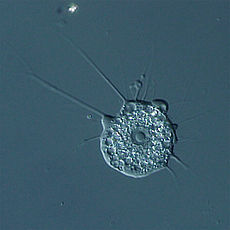홀로미코타
홀로미코타(Holomycota)는 누클레아리아류와 균류를 포함하는 생물 분류군이다.[2] "누클레트미케아"(Nucletmycea)라는 이름으로도 불린다.[1]
|
| ||
|---|---|---|
 Nuclearia | ||
| 생물 분류ℹ️ | ||
| 역: | 진핵생물 | |
| (미분류): | 후편모생물 | |
| (미분류): | 홀로미코타 (Holomycota) Liu et al., 2009 | |
학명이명 | ||
|
Nucletmycea Brown et al. 2009[1]
Holofungi | ||
| 아군 | ||
| ||
계통 분류
편집다음에 제안된 계통발생에는 엑스카바타 생물군 중 단 하나의 그룹(디스코바)만 포함되어 있으며[3] 피코조아가 홍조식물의 가까운 친척이라는 2021년 제안이 포함되어 있다.[4] 프로보라는 2022년에 발견된 미생물 포식자 집단이다.[5] 메타모나다는 아마도 디스코바, 아마도 말라이모나스문의 자매일 가능성이 있어 배치하기 어렵다.[6][7][8]
| 진핵생물 |
| ||||||||||||||||||||||||||||||||||||||||||||||||||||||||||||||||||||||||||||||||||||||||||||||||||||||||||||||||||||||||||||||||||||
| 22억 년 전? |
다음은 후편모생물의 계통 분류이다.[9][10][11][12]
| 후편모생물 |
| ||||||||||||||||||||||||||||||||||||||||||||||||||||||||||||||||||||||||||||||||||||
각주
편집- ↑ 가 나 Brown MW, Spiegel FW, Silberman JD (2009년 12월). “Phylogeny of the "forgotten" cellular slime mold, Fonticula alba, reveals a key evolutionary branch within Opisthokonta”. 《Mol. Biol. Evol.》 26 (12): 2699–709. doi:10.1093/molbev/msp185. PMID 19692665.
- ↑ Liu Y, Steenkamp ET, Brinkmann H, Forget L, Philippe H, Lang BF (2009). “Phylogenomic analyses predict sistergroup relationship of nucleariids and fungi and paraphyly of zygomycetes with significant support”. 《BMC Evol. Biol.》 9: 272. doi:10.1186/1471-2148-9-272. PMC 2789072. PMID 19939264.
- ↑ Brown, Matthew W.; Heiss, Aaron A.; Kamikawa, Ryoma; Inagaki, Yuji; Yabuki, Akinori; Tice, Alexander K; Shiratori, Takashi; Ishida, Ken-Ichiro; Hashimoto, Tetsuo; Simpson, Alastair; Roger, Andrew (2018년 1월 19일). “Phylogenomics Places Orphan Protistan Lineages in a Novel Eukaryotic Super-Group”. 《Genome Biology and Evolution》 10 (2): 427–433. doi:10.1093/gbe/evy014. PMC 5793813. PMID 29360967.
- ↑ Schön ME; Zlatogursky VV; Singh RP; 외. (2021). “Picozoa are archaeplastids without plastid”. 《Nature Communications》 12 (1): 6651. doi:10.1038/s41467-021-26918-0. PMC 8599508. PMID 34789758.
- ↑ Tikhonenkov DV; Mikhailov KV; Gawryluk RM; Belyaev AO; Mathur V; Karpov SA; Zagumyonnyi DG; Borodina AS; Prokina KI; Mylnikov AP; Aleoshin VV; Keeling PJ (2022년 12월). “Microbial predators form a new supergroup of eukaryotes”. 《네이쳐》 612 (7941): 714–719. Bibcode:2022Natur.612..714T. doi:10.1038/s41586-022-05511-5. PMID 36477531. S2CID 254436650.
- ↑ Burki F (2014년 5월). “전 지구적인 계통발생학적 관점에서 본 진핵생물의 생명나무”. 《Cold Spring Harbor Perspectives in Biology》 6 (5): a016147. doi:10.1101/cshperspect.a016147. PMC 3996474. PMID 24789819.
- ↑ Burki, Fabien; Kaplan, Maia; Tikhonenkov, Denis V.; Zlatogursky, Vasily; Minh, Bui Quang; Radaykina, Liudmila V.; Smirnov, Alexey; Mylnikov, Alexander P.; Keeling, Patrick J. (2016년 1월 27일). “Untangling the early diversification of eukaryotes: a phylogenomic study of the evolutionary origins of Centrohelida, Haptophyta and Cryptista”. 《Proc. R. Soc. B》 283 (1823): 20152802. doi:10.1098/rspb.2015.2802. PMC 4795036. PMID 26817772.
- ↑ Karnkowska, Anna; Vacek, Vojtěch; Zubáčová, Zuzana; Treitli, Sebastian C.; Petrželková, Romana; Eme, Laura; Novák, Lukáš; Žárský, Vojtěch; Barlow, Lael D. (2016). “A Eukaryote without a Mitochondrial Organelle”. 《Current Biology》 26 (10): 1274–1284. doi:10.1016/j.cub.2016.03.053.
- ↑ Peterson, Kevin J.; Cotton, James A.; Gehling, James G.; Pisani, Davide (2008년 4월 27일). “The Ediacaran emergence of bilaterians: congruence between the genetic and the geological fossil records”. 《Philosophical Transactions of the Royal Society of London B: Biological Sciences》 363 (1496): 1435–1443. doi:10.1098/rstb.2007.2233. PMC 2614224. PMID 18192191.
- ↑ Parfrey, Laura Wegener; Lahr, Daniel J. G.; Knoll, Andrew H.; Katz, Laura A. (2011년 8월 16일). “Estimating the timing of early eukaryotic diversification with multigene molecular clocks”. 《Proceedings of the National Academy of Sciences》 108 (33): 13624–13629. doi:10.1073/pnas.1110633108. PMC 3158185. PMID 21810989.
- ↑ Hehenberger, Elisabeth; Tikhonenkov, Denis V.; Kolisko, Martin; Campo, Javier del; Esaulov, Anton S.; Mylnikov, Alexander P.; Keeling, Patrick J. (2017). “Novel Predators Reshape Holozoan Phylogeny and Reveal the Presence of a Two-Component Signaling System in the Ancestor of Animals”. 《Current Biology》 27 (13): 2043–2050.e6. doi:10.1016/j.cub.2017.06.006. PMID 28648822.
- ↑ Tedersoo, Leho; Sanchez-Ramırez, Santiago; Koljalg, Urmas; Bahram, Mohammad; Doring, Markus; Schigel, Dmitry; May, Tom; Ryberg, Martin; Abarenkov, Kessy (2018년 2월 22일). “High-level classification of the Fungi and a tool for evolutionary ecological analyses”. 《Fungal Diversity》 90 (1): 135–159. doi:10.1007/s13225-018-0401-0.
- ↑ 가 나 BCG1 = basal clone group 1, BCG2 = basal clone group 2